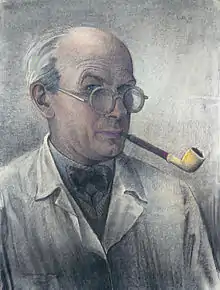Werner Heuser
Werner Heuser (1880–1964) was a German painter, engraver, drafter, and professor.[1] He had been a professor of art at the Kunstakademie Düsseldorf (Düsseldorf Art Academy) from 1926 until 1937, and he was removed from his position by the National Socialists for being a "degenerate artist". After World War II, he rebuilt the academy, serving as the Director between 1946 until 1949.[2]
Werner Heuser | |
|---|---|
 Werner Heuser, self-portrait (1937) | |
| Born | 11 November 1880 |
| Died | 11 June 1964 (aged 83) |
| Education | Kunstgewerbeschule, Kunstakademie Düsseldorf |
| Spouse | Mira Sohn-Rethel Heuser |
| Children | 2, including Ursula Benser |
| Relatives | Alfred Sohn-Rethel (brother in-law), Otto Sohn-Rethel (brother in-law), Karli Sohn-Rethel (brother in-law) |


Early life and education
Werner Heuser was born 11 November 1880 in Gummersbach, Germany to Eugenie Hoestermann and Franz Eugen Heuser.[1][2] His father was the editor of the New Braunfels Herald-Zeitung newspaper.[3] When Heuser was one year old his father ran off with his neighbor's wife, emigrated to New Braunfels, Texas and changed his name to Eugen Kailer. As a result of family issues, Werner Heuser was sent to live with his paternal family in Bonn, Germany. He attended high school in Bonn and Siegburg.
He studied at Kunstgewerbeschule (School of Applied Arts) in Dresden and at Kunstakademie Düsseldorf (Düsseldorf Art Academy) with Peter Janssen, Adolf Maennchen, and Eduard Gerhardt.
On 11 October 1907 he married in Düsseldorf, to Mira Sohn-Rethel, the daughter of painter Karl Rudolf Sohn.[4][5] Together they had two children, Klaus Heuser and Ursula Benser (née Heuser). Around 1907, Werner Heuser travelled to Rome and met up with his brother-in-laws Karli Sohn-Rethel, and Otto Sohn-Rethel, and artists Karl Hofer, Hermann Haller and Maurice Sterne.
Career
In 1919, Heuser was one of the first members of the Young Rhineland (Das Junge Rheinland) artists' group, alongside Heinrich Nauen, Adolf Uzarski, Arthur Kaufmann, Carlo Mense, Walter Ophey, and architect Wilhelm Kreis.[6]
In 1926, he was appointed to the Düsseldorf Art Academy, as a professor of drawing and composition. Some of his students included Herbert Zangs,[7] Else Harney,[8] Georg Meistermann,[9] Caspar Walter Rauh,[10] among others.
Entartete Kunst exhibit
Between 1927 until 1937, Germany was experienced a rise in Nazi Party power.[11] In 1927, the National Socialist Society for German Culture was formed, in order to halt the "corruption of art" and inform the people about the relationship between race and art through pseudoscientific racist theories.[11] Starting in 1933, the group labeled modern artwork and artists as "Jewish," "degenerate," and "Bolshevik".[11]
In 1937, the Nazi officials purged German museums and removed the art they considered to be degenerate and formed a special exhibit of the work called, Entartete Kunst.[11] Entartete Kunst featured 650 works of art and travelled throughout Germany, and was popular with viewers.[11] Heuser was one of the artists in the exhibition and he was labeled as a "degenerate". That same year, 1937, Heuser's contract work as a professor was not extended.
World War II and post-war
During World War II he initially was staying in Sanary-sur-Mer, followed by a stay in Allgäu and Breisgau. In 1943, the Sohn-Rethel home at Goltsteinstraße 23 in Düsseldorf, where he lived and worked, was fire bombed destroying his art work and his art collection. He followed his family to Bollschweil by 1945. After the end of National Socialist rule, he returned to Düsseldorf and by 1 November 1945 he resumed teaching.
He was appointed as Director of the Düsseldorf Art Academy on 7 January 1946, and by 31 January 1946, the school was rebuilt and reopened.[12]
Death and legacy
Werner Heuser died of heart failure in Düsseldorf on 11 June 1964 and is buried at Nordfriedhof Düsseldorf cemetery.
His daughter Ursula Benser (1915–2001) was a painter, and she was married to photographer Walther Benser.
His work is included in various collections, including the Library of Congress.[13]
Exhibitions
- 1912 – Internationale Kunstausstellung des Sonderbundes Westdeutscher Kunstfreunde und Künstler (International art exhibition of the Sonderbund West German art lovers and artists), Cologne, Germany[14]
- 1941 – Große Deutsche Kunstausstellung (Great German Art Exhibition), Munich, Germany[15]
References
- Heuser, Werner. Vol. 1. Oxford University Press, Benezit Dictionary of Artists. 31 October 2011. doi:10.1093/benz/9780199773787.article.b00087222. ISBN 978-0-19-977378-7.
- "Heuser, Werner". Neue Deutsche Biographie (in German). 1972. Retrieved 15 August 2020.
- "The History of The Herald-Zeitung". Herald-Zeitung. Archived from the original on 11 March 2010. Retrieved 15 August 2020.
- Der Querschnitt (in German). Vol. 4. Kraus Reprint. 1970. p. 384.
- Böttcher, Kirsten (1 June 2016). "Else Sohn-Rethels Memoiren, Das Turbulente Leben einer Künstlergattin" [Else Sohn-Rethel's Memoirs, The Turbulent Life of an Artist's Wife]. Radio Bayern 2, Kultur. Archived from the original on 18 August 2016. Retrieved 19 August 2020.
- Ey, Johanna (2014). "Mutter der rheinischen Avantgarde. Eine regionale Kunstgeschichte". www.rheinische-art.de (in German). Retrieved 19 August 2020.
- Meister, Helga (4 February 2020). "Herbert Zangs: Die Entthronung eines Krefelder Originals". Westdeutsche Zeitung (in German). Retrieved 19 August 2020.
- "Else Harney". Freeforms. Retrieved 19 August 2020.
- Inge Herold, "Meistermann, Georg", AKL, vol. 88, Berlin and Boston, 2016, pp. 535-536.
- "Caspar Walter Rauh". Askart.com. Retrieved 19 August 2020.
- "A Teacher's Guide to the Holocaust, Degenerate Art, Entartete Kunst". University of South Florida (USF). Florida Center for Instructional Technology, College of Education, University of South Florida (USF). Retrieved 19 August 2020.
- "1946 - Wiedereröffnung Kunstakademie Düsseldorf". Kulturkenner. Retrieved 20 August 2020.
- "Kriegsbilderbogen Münchner Künstler". Library of Congress. Retrieved 19 August 2020.
Collection of signed and hand-colored lithographs by 24 Munich, Germany based artists show images and impressions mostly critical of the first world war.
- Internationale Kunstausstellung des Sonderbundes Westdeutscher Kunstfreunde und Künstler zu Cöln, 1912. Solomon R. Guggenheim Museum Library, Sonderbund Westdeutscher Kunstfreunde und Künstler. Cöln a. Rhein : M. Dumont Schauberg. 1912.
{{cite book}}: CS1 maint: others (link) - "Schäfer — Die Großen Deutsche Kunstausstellungen 1937 – 1944/45". www.gdk-research.de. Retrieved 20 August 2020.